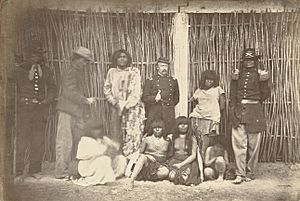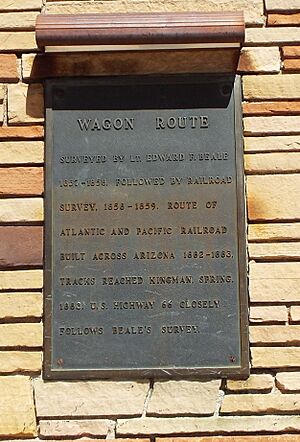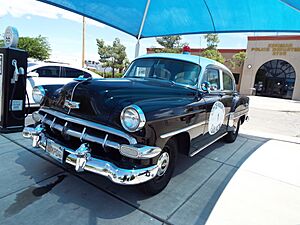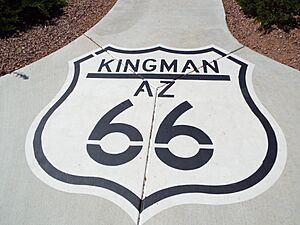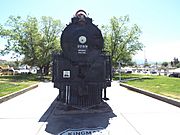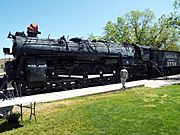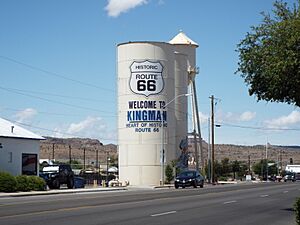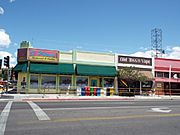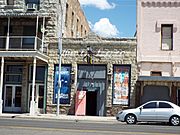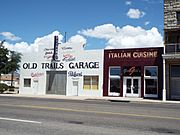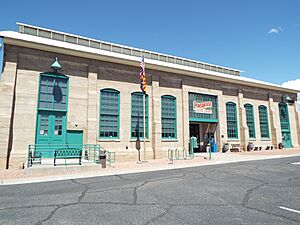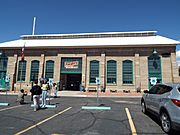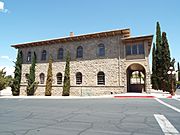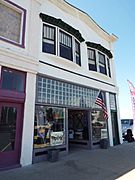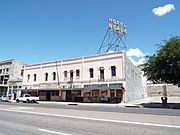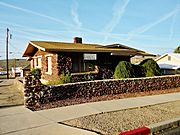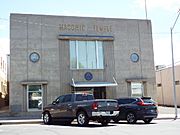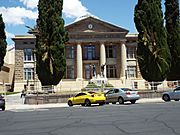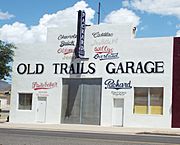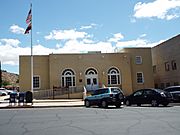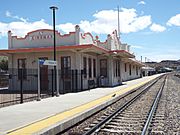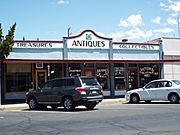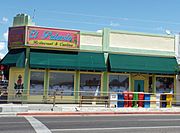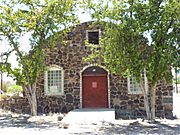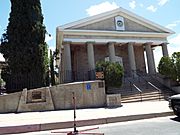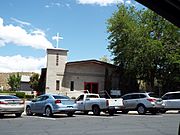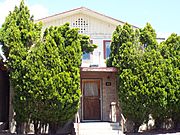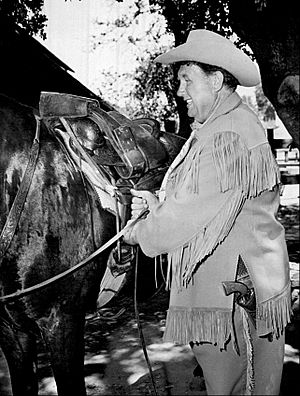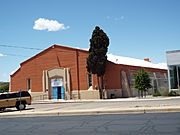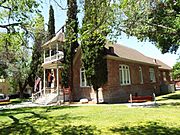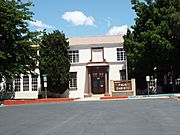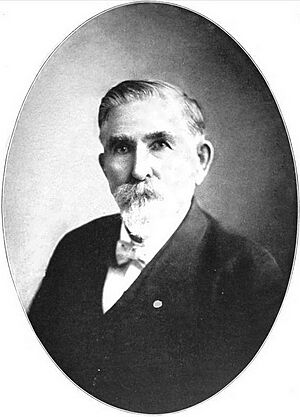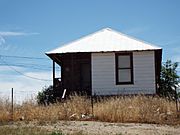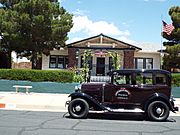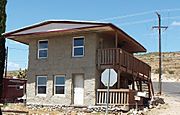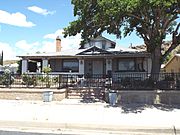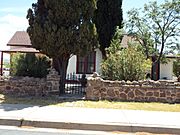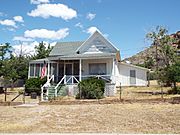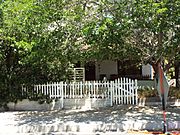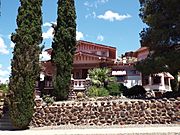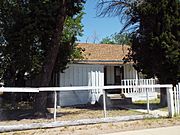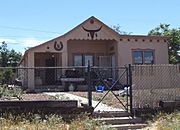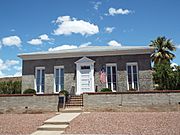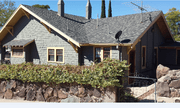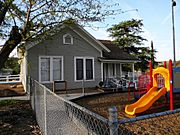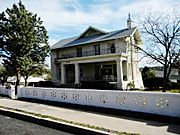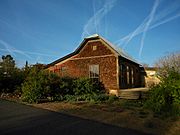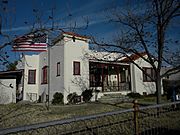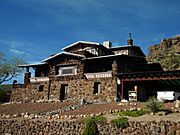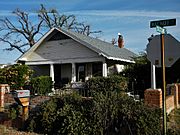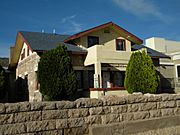List of historic properties in Kingman, Arizona facts for kids
Quick facts for kids
List of historic properties in Kingman, Arizona
|
|
|---|---|

Kingman Historic Commercial District
|
|
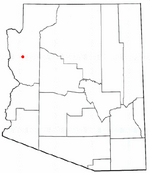
Location of Kingman in Mohave County, Arizona.
|
This article is like a photo album of some of the oldest and most important buildings, homes, and monuments in Kingman, Arizona. Many of these places are so special that they are listed on the National Register of Historic Places (NRHP). This means they are recognized as important parts of American history. You'll also see pictures of a cool old steam engine, #3759, which was built way back in 1927 for the Santa Fe Railroad!
Contents
Kingman's Early Days
Long, long ago, the first people to live in the Kingman area were the Anasazi, also known as the "Ancient Ones." Later, Native American tribes like the Hualapai, Havasupai, and Mohave lived here.
The first Europeans to explore this area were the Spanish, led by Marcos de Niza in 1539. They were looking for gold! The next year, Francisco Vásquez de Coronado also explored the region. For a while, Arizona was part of Mexico. But not many Mexicans settled here.
In 1849, when the California Gold Rush started, many people from the eastern United States and Europe began traveling through the area. They were also looking for gold, and some decided to stay and build homes.
Between 1830 and 1860, the United States grew a lot, even fighting a war with Mexico. After the Mexican–American War ended in 1848, a treaty was signed that gave the northern parts of Mexico, including Arizona, to the United States.
At first, the new settlers and the Mohave people got along well. The Mohaves traded wild game and supplies, and even helped guide travelers. But the settlers were still a bit worried about possible attacks.
Beale's Wagon Road: A Path to the West
In 1857, President James Buchanan asked Edward Fitzgerald Beale to create a 1,000-mile wagon road. This road would go from Fort Defiance, Arizona all the way to the Colorado River, which is the border between Arizona and California. It followed the 35th parallel.
The wagon trail started in Fort Smith, Arkansas, went through New Mexico, and then across northern Arizona to Camp Beale Springs, which is near where Kingman is today. Many settlers used this road to move west. In Kingman, you can find a marker that shows where this old wagon trail was. It later became part of the famous U.S. Route 66 and the path for the Transcontinental railroad.
The Atlantic & Pacific Railroad Arrives
Lewis Kingman was a civil engineer who helped build thousands of miles of railroad tracks. He worked for the Atlantic & Pacific Railroad. In 1880, Lewis Kingman was given the job of planning and building a railroad line from Flagstaff, Arizona to the Colorado River. He was in charge of building the railroad from Winslow to Beale Springs. By December 1881, he was the chief engineer for the whole railroad construction project.
Much of the new railroad line followed the same path as Beale's Wagon Trail. Under his guidance, the tracks reached the spot where Kingman is now. He chose this area as a good place to store railroad building materials.
Kingman Becomes a City
The town of Kingman was officially named in 1882, after Lewis Kingman. The first part of Kingman was located between what are now First and Sixth, Pine, and Golconda streets.
A woman named Johanna Wilkinson and her sister Francis came to Kingman in the early 1880s. Johanna's brother, who worked for the railroad, told her that the workers didn't have much to eat, mostly just rabbits they caught. He told Johanna she could make "good money" cooking for them. So, Johanna and Francis traveled over 300 miles with their supplies. They set up a tent right across from the train station Lewis Kingman had built. They cooked on an iron stove and fed the workers, who sat on boxes and ate on boards.
Their business did very well! Johanna and Francis added a wood floor to their restaurant. They also realized the workers were sleeping in train cars or on the ground, so they set up more tents and rented out beds.
As Kingman grew into a mining town, Johanna married Harvey Hubbs. Together, they built Kingman's first hotel, the Hubbs House. Miners smoking in bed caused the hotel to catch fire nine times! Since water had to be brought in from far away, there wasn't enough to fight the fires. They built another Hubbs House, which was the first two-story building in Kingman. Later, they partnered with Beale to build the Beale Hotel, which you can still see today.
Harvey and Johanna's own home was later fixed up by the city and is now on the National Register of Historic Places. Harvey was also the county sheriff and county treasurer, and he owned mines. He even brought Kingman its first water system!
Kingman was a railroad town, and it kept growing even when many other Arizona towns, which were built around mines, started to shrink after the mines ran out.
In 1887, Kingman was chosen to be the county seat for Mohave County. This meant the main government offices moved there. Kingman officially became a city in 1952.
Some of Kingman's oldest buildings include the Little Red Schoolhouse, built in 1896. Famous actor Andy Devine went to school there! The Saint John's Methodist Episcopal Church, built in 1917, looks like an ancient Greek Temple. A fun fact: on March 29, 1939, movie stars Clark Gable and Carole Lombard got married there!
Many buildings in Kingman are listed on the National Register of Historic Places. This means they are recognized as important historical sites. Even if a building is listed, its owner can still choose to tear it down. However, being listed often helps protect these special places.
Route 66: The Mother Road
Route 66, often called "The Mother Road," became an official highway in 1926. It was a huge road that connected Chicago all the way to Los Angeles! During its busiest times, Route 66 linked small towns and big cities.
This road was super important for hundreds of thousands of people in the 1930s. They packed up their lives to escape the terrible Dust Bowl and traveled west, hoping for a better future. Route 66 went right through Kingman, on what was once called "Front Street" and is now Andy Devine Avenue. It helped Kingman's businesses a lot. Even though it's historic, Route 66 stopped being an official U.S. Highway in 1985.
The Historic Powerhouse Building in Kingman used to provide electricity to the town and nearby mines. But after the Hoover Dam started making power in the late 1930s, the Powerhouse wasn't needed for electricity anymore. Now, it's home to the Arizona Route 66 Museum!
Mohave County Historical Society
The Mohave County Historical Society is located at 400 West Beale Street. Their goal is to collect, keep safe, and share the history of Mohave County with everyone.
Historic Properties in Kingman
Kingman has many amazing historic properties. Here's a look at some of them:
AT&SF Locomotive #3759
- AT&SF Locomotive #3759 – This huge steam engine was built in 1927 for the Atchison, Topeka and Santa Fe Railway. It's a "Northern" type steam locomotive. You can see it on display in Locomotive Park, located between Andy Devine Avenue and Beale Street in Kingman. This locomotive is so important that it was added to the National Register of Historic Places in 1986.
Kingman Commercial Historic District
- The Kingman Commercial Historic District – This area includes the 300 and 400 blocks of Andy Devine Avenue. The buildings here show different styles, like Moderne, Queen Anne, and Mission/Spanish Revival. Some were even designed by a famous architect named W. Royal Lescher. This whole district was added to the National Register of Historic Places in 1986. The Luthy Block, a part of this district, was built in 1908.
Historic Buildings
Here are some of the historic business buildings in Kingman. Some are listed on the National Register of Historic Places on their own, and others are part of the Kingman Commercial Historic District. The names listed are their original names.
- The Armour and Jacobson Building – Built in 1921 at 426-430 Beale Street. It used to have a bakery and an office where people tested minerals.
- The AT and T Building – Built in 1930 at Pine and 3rd Streets.
- The Brunswick Hotel – Built in 1909 at 315 E Andy Devine Avenue. It was the first three-story building in the county! Famous people like Clark Gable stayed here.
- The Building on 409 Andy Devine Ave. – Built in 1908. This building used to be home to a martial arts school.
- The Central Commercial Building – Built in 1917 at 154 N 4th Street. When it first opened, it was known as "America's most amazing country store."
- The Desert Power & Water Co. – Built in 1907. This was one of the biggest steam electric power plants in the Western United States! It stopped working in 1938 when the Hoover Dam started making power.
- The Elk's Lodge#468 – Built in 1903 at 4th and Oak Streets. The stone for this building came from the Metcalfe Quarry.
- The W. A. Gruninger Building – Built in 1921 at 424 Beale Street. It was built as an investment, with shops on the first floor and offices upstairs.
- The H. Lovin Building – Built in 1906 at 317 Andy Devine Avenue. Henry Lovin, a businessman, had this building constructed between the Beale and Brunswick hotels.
- The Hotel Beale – Built in 1900 at 325 E Andy Devine Avenue. In 1906, actor Andy Devine's father, Tom Devine, bought it. Clark Gable and Carole Lombard also stayed here. It was once the best hotel in Kingman.
- The IOOF Building – Built in 1912 at 208 N. 5th Street. IOOF stands for "Independent Order of Odd Fellows," a social club.
- The Lovin & Withers Investment House – Built in 1914 at 722 E. Beale Street.
- The Lovin and Withers Cottages – Built in 1916 at 8th and Topeka.
- The Masonic Temple – Built in 1939 at 212 N. 4th Street.
- The Mohave County Courthouse and Jail – Built in 1909 at 310 N. 4th Street.
- The Old Trails Garage – Built in 1915 at 307 and 308 Andy Devine Avenue.
- The Ed Thompson's Saloon – Built in 1915 at 311 Andy Devine Avenue. This building once housed an "Italian Cuisine" restaurant.
- The Kingman Santa Fe Depot – Built in 1907 at 400 E. Andy Devine Avenue. This was the train station!
- The G. H. Sullivan Lodging House – Built in 1911 at 218 E. Oak.
- The U.S. Post Office in Kingman – Built in 1935 at 310 N. 4th Street.
- The Van Marter Building – Built in 1921 at 423-427 Beale Street. It used to have a mortician's (funeral director's) and shoemaking shops.
- The Watkins Pioneer Drugstore – Built in 1883 at 401 E Andy Devine Avenue. H. H. Watkins and his brother opened Kingman's very first drugstore here.
Historic buildings not pictured:
- Kingman Army Air Forces Flexible Gunnery School Radio Tower – Located at 7000 Flightline Drive.
- The Mohave County Hospital – Located W. Beale between Grand View and 1st Street.
Houses of Religious Worship
These are some of the historic churches in Kingman:
- Assembly of God Church – Built in 1939 at 484 E. Pask Street.
- Saint John's Methodist Episcopal Church – Built in 1917 at Spring and 5th Streets. Remember, Clark Gable and Carole Lombard got married here in 1939! This church is on the National Register of Historic Places.
- St. Mary's Catholic Church and Rectory – Built in 1906 on 3rd and Spring Streets. This church is also on the National Register of Historic Places.
- Houses of religious worship
Historic Schools
Here are some of the old schools in Kingman:
- The Mohave Union High School Gymnasium – Built in 1936 at 301 1st Street. This gym is unique because it's the only building in Kingman with "buttresses" (supports sticking out from the wall) and a special "lamella roof" design. It's on the National Register of Historic Places.
- The Little Red Schoolhouse – Built in 1896 at 219 N. 4th Street. Actor Andy Devine went to this school! It's also on the National Register of Historic Places.
- Palo Christi School – Built in 1928 at 500 Maple Street. This school was originally called "Kingman Grammar School" and is listed on the National Register of Historic Places.
Historic Homes
Here's a quick look at some of the historic houses in Kingman. Many of them are listed as historical by the National Register of Historic Places.
- The House on 202 E. Park St. – Built in 1910 at 202 E. Park Street.
- The Bonelli House – Built in 1900 at Spring and 5th Streets.
- The Cohenour House – Built in 1911 at 105 Spring Street.
- The House on 843 E. Andy Divine Ave. – Built in 1935.
- The Lefever House – Built in 1900 at 525 E. Oak Street.
- The Mrs. M. P. Sergent House – Built in 1897 at 426 Topeka.
- The R.L. Anderson House – Built in 1915.
- The Ross Blakeley House – Built in 1897 at 519 E. Spring Street.
- The Ross E. Householder House – Built between 1916 and 1923 at 431 Spring Street.
- The S.T. Elliot House – Built in 1917 at 537 Spring Street.
- The Tyrell House – Built in 1897 at 133 Beale Street.
- The W. H. Taggart Home – Built in 1883. W.H. Taggart helped build the Mohave County Courthouse and was one of the first people to build a big home in Kingman.
- The William G. Blakeley House – Built in 1887 at 503 Spring Street. Blakeley was a preacher and a judge.
- The E. B. Williams House – Built in 1887 at 531 E. Oak Street.
- The Duff Brown house – Built in 1911 at 524 E. Oak Street.
- The Hubbs House – Built in 1891 at 4th and Golconda Streets. This was the first hotel built by Johanna and Harvey Hubbs!
- The Raymond Carr House – Built in 1916 at 620 E. Oak Street.
- The Foster S. Dennis House – Built in 1889 at 2nd and Park Street. Foster S. Dennis owned a plant that processed minerals in Kingman.
- The George R. Kayser House – Built in 1898 at 604 E. Oak Street.
- The House on 809 Grandview – Built in 1923 at 809 Grandview Avenue.
- The House at 527 Pine St. – Built in 1917 at 527 Pine Street.
- The House at 536 East Park St – Built in 1906 at 536 East Park Street.
- The W. P. Mahoney House – Built between 1919 and 1923 at 155 E. Walnut.
- The Dr. Toler White House – Built in 1916 at 509 Spring Street.
- The J. B. Wright House – Built in 1912 at 317 Spring Street.
- The Max J. Anderson House – Built in 1927 at 703 E. Beale Street. This house was built using local stone.
Historic houses not pictured:
- The Arthur F. Black House – Built in 1925 at 707 Cerbat Avenue.
- The J. M. Gates House – Built in 1915 at 714 E. Oak Street.
- The House at 519 Golconda – Built in 1897 at 519 Golconda Street.
- The Dr. David S. Livingston House – Built in 1889 at 222 Topeka Street.
- The O. E. Walker House – Built in 1916 at 906 Madison Street.
- Historic houses
Special Historic Sites
Some historic places have addresses that are kept private for their protection. However, one important site, Camp Beale Springs, is now open for everyone to visit!
- Camp Beale Springs – Native Americans used Beale's Spring for hundreds of years before Edward Beale explored the area in the 1850s. It's on the National Register of Historic Places.
- Northern Avenue Petroglyph Site – This is an archeological site with ancient rock carvings (petroglyphs). It was a special place for ceremonies and animals in Arizona's past. It's also on the National Register of Historic Places.
See also


